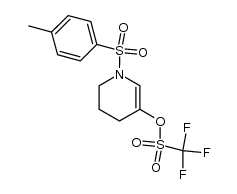CHEMICAL IDENTIFICATION
-
RTECS NUMBER :
-
RM2979500
-
CHEMICAL NAME :
-
Ormosanine, 16,17-didehydro-9-de-2-piperidinyl-, (7-alpha,9-alpha)-
-
CAS REGISTRY NUMBER :
-
56293-29-9
-
LAST UPDATED :
-
199612
-
DATA ITEMS CITED :
-
6
-
MOLECULAR FORMULA :
-
C15-H24-N2
-
MOLECULAR WEIGHT :
-
232.41
HEALTH HAZARD DATA
ACUTE TOXICITY DATA
-
TYPE OF TEST :
-
LD50 - Lethal dose, 50 percent kill
-
ROUTE OF EXPOSURE :
-
Oral
-
SPECIES OBSERVED :
-
Rodent - rat
-
DOSE/DURATION :
-
480 mg/kg
-
TOXIC EFFECTS :
-
Details of toxic effects not reported other than lethal dose value
-
REFERENCE :
-
CYLPDN Zhongguo Yaoli Xuebao. Acta Pharmacologica Sinica. Chinese Journal of Pharmacology. (China International Book Trading Corp., POB 2820, Beijing, Peop. Rep. China) V.1- 1980- Volume(issue)/page/year: 10,360,1989
-
TYPE OF TEST :
-
LD50 - Lethal dose, 50 percent kill
-
ROUTE OF EXPOSURE :
-
Intravenous
-
SPECIES OBSERVED :
-
Rodent - rat
-
DOSE/DURATION :
-
75 mg/kg
-
TOXIC EFFECTS :
-
Details of toxic effects not reported other than lethal dose value
-
REFERENCE :
-
ZYZAEU Zhongguo Yaoxue Zazhi. Chinese Pharmacuetical Journal. (China International Book Trading Corp., POB 2820, Beijing, Peop. China) V.24- 1989- Volume(issue)/page/year: 27,201,1992
-
TYPE OF TEST :
-
LD50 - Lethal dose, 50 percent kill
-
ROUTE OF EXPOSURE :
-
Oral
-
SPECIES OBSERVED :
-
Rodent - mouse
-
DOSE/DURATION :
-
869 mg/kg
-
TOXIC EFFECTS :
-
Details of toxic effects not reported other than lethal dose value
-
REFERENCE :
-
CTYAD8 Zhongcaoyao. Chinese Traditional and Herbal Medicine. (China International Book Trading Corp., POB 2820, Beijing, Peop. Rep. China) V.11- 1980- Volume(issue)/page/year: 18,214,1987
-
TYPE OF TEST :
-
LD50 - Lethal dose, 50 percent kill
-
ROUTE OF EXPOSURE :
-
Intraperitoneal
-
SPECIES OBSERVED :
-
Rodent - mouse
-
DOSE/DURATION :
-
154 mg/kg
-
TOXIC EFFECTS :
-
Details of toxic effects not reported other than lethal dose value
-
REFERENCE :
-
ZYZAEU Zhongguo Yaoxue Zazhi. Chinese Pharmacuetical Journal. (China International Book Trading Corp., POB 2820, Beijing, Peop. China) V.24- 1989- Volume(issue)/page/year: 27,201,1992
-
TYPE OF TEST :
-
LD50 - Lethal dose, 50 percent kill
-
ROUTE OF EXPOSURE :
-
Intravenous
-
SPECIES OBSERVED :
-
Rodent - mouse
-
DOSE/DURATION :
-
75 mg/kg
-
TOXIC EFFECTS :
-
Details of toxic effects not reported other than lethal dose value
-
REFERENCE :
-
CTYAD8 Zhongcaoyao. Chinese Traditional and Herbal Medicine. (China International Book Trading Corp., POB 2820, Beijing, Peop. Rep. China) V.11- 1980- Volume(issue)/page/year: 17,170,1986
-
TYPE OF TEST :
-
LD50 - Lethal dose, 50 percent kill
-
ROUTE OF EXPOSURE :
-
Intravenous
-
SPECIES OBSERVED :
-
Rodent - rabbit
-
DOSE/DURATION :
-
75 mg/kg
-
TOXIC EFFECTS :
-
Details of toxic effects not reported other than lethal dose value
-
REFERENCE :
-
ZYZAEU Zhongguo Yaoxue Zazhi. Chinese Pharmacuetical Journal. (China International Book Trading Corp., POB 2820, Beijing, Peop. China) V.24- 1989- Volume(issue)/page/year: 27,201,1992
|



![(6R,7R,13R,14R,15S)-14-hydroxy-1-(p-toluenesulfonyl)-tetradecahydro-6,13-methano-dipyrido[1,2-a,3',2'-e]azocin-12-one structure](https://image.chemsrc.com/caspic/098/220384-61-2.png)

